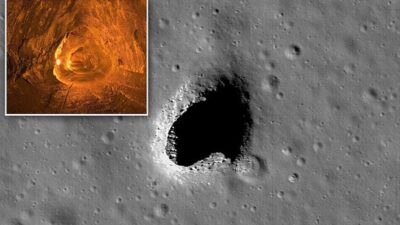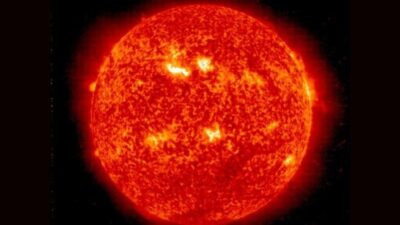A dense, collapsed famous person spinning 707 instances in step with second—making it one of the quickest spinning neutron stars withinside the Milky Way galaxy—has shredded and ate up almost the complete mass of its stellar partner and, withinside the process, grown into the heaviest neutron famous person located to date.
Weighing this document-placing neutron famous person, which tops the charts at 2.35 instances the mass of the sun, allows astronomers apprehend the bizarre quantum country of remember interior those dense gadgets, which—in the event that they get lots heavier than that—fall apart totally and disappear as a black hollow.
“We recognise more or less how remember behaves at nuclear densities, like withinside the nucleus of a uranium atom,” stated Alex Filippenko, Distinguished Professor of Astronomy on the University of California, Berkeley. “A neutron famous person is like one massive nucleus, however if you have one-and-a-1/2 of sun loads of this stuff, which is ready 500,000 Earth loads of nuclei all clinging collectively, it is on no account clean how they may behave.”
Roger W. Romani, professor of astrophysics at Stanford University, mentioned that neutron stars are so dense—1 cubic inch weighs over 10 billion tons—that their cores are the densest remember withinside the universe quick of black holes, which due to the fact they may be hidden at the back of their occasion horizon are not possible to examine. The neutron famous person, a pulsar distinctive PSR J0952-0607, is consequently the densest item nearby of Earth.
The size of the neutron famous person’s mass turned into viable way to the intense sensitivity of the 10-meter Keck I telescope on Maunakea in Hawai’i, which turned into simply capable of document a spectrum of seen mild from the hotly sparkling partner famous person, now decreased to the dimensions of a huge gaseous planet. The stars are approximately three,000 mild years from Earth withinside the course of the constellation Sextans.
Discovered in 2017, PSR J0952-0607 is called a “black widow” pulsar—an analogy to the tendency of girl black widow spiders to devour the lots smaller male after mating. Filippenko and Romani had been analyzing black widow structures for greater than a decade, hoping to set up the top restriction on how huge neutron stars/pulsars can grow.
“By combining this size with the ones of numerous different black widows, we display that neutron stars have to attain as a minimum this mass, 2.35 plus or minus 0.17 sun loads,” stated Romani, who’s a professor of physics in Stanford’s School of Humanities and Sciences and member of the Kavli Institute for Particle Astrophysics and Cosmology. “In turn, this presents a number of the most powerful constraints at the belongings of remember at numerous instances the density visible in atomic nuclei. Indeed, many in any other case famous fashions of dense-remember physics are excluded via way of means of this result.”
If 2.35 sun loads is near the top restriction of neutron stars, the researchers say, then the indoors is probably to be a soup of neutrons in addition to up and down quarks—the materials of ordinary protons and neutrons—however now no longer unique remember, such as “bizarre” quarks or kaons, which might be debris that comprise a bizarre quark.
“A excessive most mass for neutron stars shows that it’s far a aggregate of nuclei and their dissolved up and down quarks all of the manner to the center,” Romani stated. “This excludes many proposed states of remember, specifically people with unique indoors composition.”
Romani, Filippenko and Stanford graduate scholar Dinesh Kandel are co-authors of a paper describing the team’s outcomes that has been prevalent for book via way of means of The Astrophysical Journal Letters.
How huge can they grow?
Astronomers commonly agree that once a celeb with a center large than approximately 1.four sun loads collapses on the quit of its life, it paperwork a dense, compact item with an indoors below such excessive stress that every one atoms are smashed collectively to shape a sea of neutrons and their subnuclear materials, quarks. These neutron stars are born spinning, and aleven though too dim to be visible in seen mild, screen themselves as pulsars, emitting beams of mild—radio waves, X-rays or maybe gamma rays—that flash Earth as they spin, just like the rotating beam of a lighthouse.
“Ordinary” pulsars spin and flash approximately as soon as in step with second, on average, a velocity which can without problems be defined given the ordinary rotation of a celeb earlier than it collapses. But a few pulsars repeat loads or as much as 1,000 instances in step with second, that’s tough to give an explanation for except remember has fallen onto the neutron famous person and spun it up. But for a few millisecond pulsars, no partner is seen.
One viable reason for remoted millisecond pulsars is that every did as soon as have a partner, however it stripped it right all the way down to nothing.
“The evolutionary pathway is actually fascinating. Double exclamation point,” Filippenko stated. “As the partner famous person evolves and begins offevolved turning into a crimson massive, cloth spills over to the neutron famous person, and that spins up the neutron famous person. By spinning up, it now turns into particularly energized, and a wind of debris begins offevolved popping out from the neutron famous person. That wind then hits the donor famous person and begins offevolved stripping cloth off, and over time, the donor famous person’s mass decreases to that of a planet, and if even greater time passes, it disappears altogether. So, it is how lone millisecond pulsars will be formed. They were not all by myself to start with—they needed to be in a binary pair—however they progressively evaporated away their partners, and now they are solitary.”
The pulsar PSR J0952-0607 and its faint partner famous person guide this starting place tale for millisecond pulsars.
“These planet-like gadgets are the dregs of ordinary stars that have contributed mass and angular momentum, spinning up their pulsar pals to millisecond intervals and growing their mass withinside the process,” Romani stated.
“In a case of cosmic ingratitude, the black widow pulsar, which has wolfed a huge a part of its mate, now heats and evaporates the partner right all the way down to planetary loads and possibly entire annihilation,” stated Filippenko.
Spider pulsars consist of redbacks and tidarrens
Finding black widow pulsars wherein the partner is small, however now no longer too small to detect, is certainly considered one among few methods to weigh neutron stars. In the case of this binary system, the partner famous person—now handiest 20 instances the mass of Jupiter—is distorted via way of means of the mass of the neutron famous person and tidally locked, much like the manner our moon is locked in orbit in order that we see handiest one facet. The neutron famous person-dealing with facet is heated to temperatures of approximately 6,two hundred Kelvin, or 10,seven hundred stages Fahrenheit, a piece warmer than our sun, and simply brilliant sufficient to peer with a huge telescope.
Filippenko and Romani became the Keck I telescope on PSR J0952-0607 on six activities over the past 4 years, on every occasion gazing with the Low Resolution Imaging Spectrometer in 15-minute chunks to trap the faint partner at precise factors in its 6.four-hour orbit of the pulsar. By evaluating the spectra to that of comparable sun-like stars, they have been capable of degree the orbital speed of the partner famous person and calculate the mass of the neutron famous person.
Filippenko and Romani have tested approximately a dozen black widow structures so far, aleven though handiest six had partner stars brilliant sufficient to allow them to calculate a mass. All worried neutron stars much less large than the pulsar PSR J0952-060. They’re hoping to examine greater black widow pulsars, in addition to their cousins: redbacks, named for the Australian equal of black widow pulsars, that have partners in the direction of one-10th the mass of the sun; and what Romani dubbed tidarrens—wherein the partner is round one-hundredth of a sun mass—after a relative of the black widow spider. The male of this species, Tidarren sisyphoides, is ready 1% of the girl’s size.
“We can preserve seeking out black widows and comparable neutron stars that skate even in the direction of the black hollow brink. But if we do not discover any, it tightens the argument that 2.three sun loads is the genuine restriction, past which they turn out to be black holes,” Filippenko stated.
“This is proper on the restriction of what the Keck telescope can do, so barring high-quality gazing conditions, tightening the size of PSR J0952-0607 probably awaits the 30-meter telescope era,” delivered Romani.
Other co-authors of the ApJ Letters paper are UC Berkeley researchers Thomas Brink and WeiKang Zheng.









